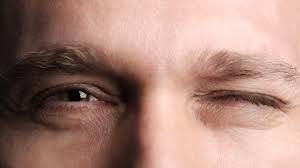
HFS:
Involuntary, irregular, clonic or tonic contractions of muscles innervated by the facial nerve.
Usually start from the eyelid and spreads to involve all ipsilateral muscles of the facial nerve including platysma. All muscles involved contract synchronously.

Senior Registrar Neurology, PKLI & RC. Lahore
PAradoxical synkinesis: In 1905, Babinski described paradoxical synkinesis in HFS ‘‘when orbicularis oculi contracts and the eye closes, the internal part of the frontalis contracts at the same time, the eyebrow rises during eye occlusion.’’ This ‘‘other Babinski’s sign’’ is typically present in HFS, but not in essential blepharospasm.
Mostly unilateral, if bilateral, is not synchronous.
Precipitated or exacerbated by facial movements or by stress, anxiety or fatigue.
Differentials:
 Myokymia:
Myokymia:
Rippling or undulating movements beneath the skin due to involuntary contractions of small muscles or muscle fascicles.
Usually benign and due to sleeplessness, caffeine intake, excessive fatigue.
Rarely has underlying etiologies eg: MS brainstem lesions, GBS, SCA type 3
EMG: brief bursts of single motor unit potentials firing at rates of 5–150Hz. The bursts may appear as doublets, triplets, or multiplets on EMG, followed by short periods of electrical silence.
Myorhythmia:
Coarse, synchronous or asynchronous, relatively slow, 1–3 Hz, rhythmical, tremor-like involuntary movement involving face and may involve other body parts. If occurs in isolation in face or without ocular myorhythmia, may be misdiagnosed.
 Facial tics:
Facial tics:
Can be differentiated by history(urge or premonitory sensation), and on the basis of presence of other tics. Are abrupt, stereotypical, usually brief and nonsustained.
Psychogenic:
Nonpatterned movements with variable intensity and distractable. Seen in relatively younger patients.
Facial myoclonus:
May have associated EEG changes. Movements may be more generalized and more rhythmic.
Blepharospasm or oromandibular dystonia:
Bilateral, synchronous, sustained, oromandibular dystonia will involve muscles not supplied by the seventh cranial nerve like the pterygoids, masseters and temporalis. The other Babinski sign is typically not present.
Synkinesis following facial paresis: Occurs in the context of voluntary contraction of the facial muscles.
Dyskinesias:
Drug-induced late-onset dyskinesias, mainly by neuroleptics, manifest as stereotypical orofacial, lingual and limb movements, and akathisia. These may be supressible partially.
Focal seizure:
Repetitive focal clonic jerking that will have associated EEG correlate.




